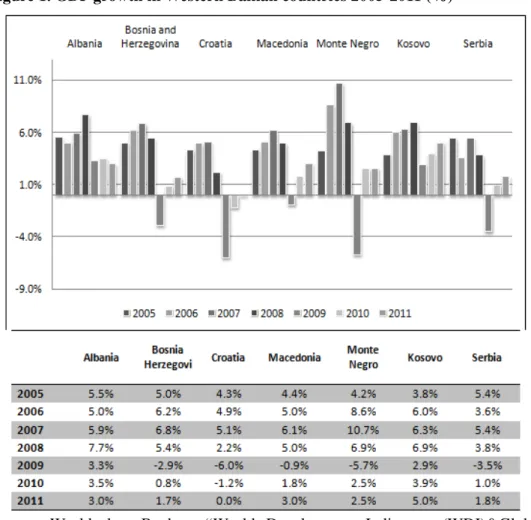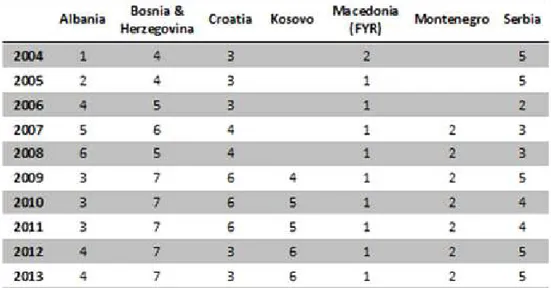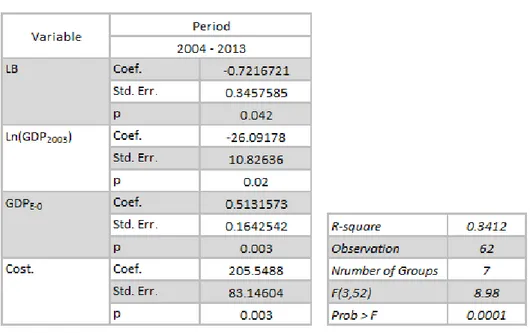Business regulation and economic growth in the
Western Balkan countries
Engjell PERE
*, Albana HASHORVA
**Abstract
Actually economic policies in many countries aimed to stimulate their economic growth, particularly after negative impact of the global economic crisis. In this regards, fiscal regulation are an important aspect of those policies, that can promote or obstacle the economic growth in general. In this point of view this paper aims to analyze the system of administration rules in different Western Balkans Countries, (which includes Albania, Bosnia & Herzegovina, Croatia, Kosovo, Macedonia (FYROM), Montenegro and Serbia). Moreover, a special attention is given investigation of the regulation and administrative facilitation aspects of doing business in the above-mentioned countries, whether this system stimulates, or not, the development of private business and economic growth. The paper is divided into three main sections. The first part provides a retrospective of economic growth in the Western Balkan countries and the dependence of this growth on global economic development. The second part proceeds with the investigations of the impact of administrative regulation on economic growth. The third part, based on an econometric model, will analyze the correlation between economic growth and elaborated indicators which present the level of business administrative regulation system. Furthermore, this last section discusses the results and concludes. In this analysis, the paper is based substantially onthe data base of "Doing Business 2013" (World Bank).
Keywords: economic growth, economic regulation, fiscal system, fiscal policy
JEL Classification: O12, O17, O50, P48
*
Engjell Pere is Head of Management & Economics Department, European University of Tirana (UET), Albania; e-mail: engjell.pere@uet.edu.al.
**
1. Introduction: economic growth in Western Balkan countries
In terms of macroeconomic figures, economic growth and in particular GDP
has been one of the most positive and stable characteristics of Western Balkans.
Compared with the average growth of 27 countries in the European Union (EU 27),
the GDP growth in Western Balkan countries shows that before theeconomic crisis,
all these countries were faced with a significant and rapid increase of economic output. Considered a normal economic development, with an average increased about 6-7%, in the period 2005-2007, the GDP growth in the economies of the
Western Balkans was higher than in the EU. In 2007, real GDP growth in
Montenegro was 10.7%, in Bosnia and Herzegovina 6.8%; in Kosovo 6.3%; in Macedonia 6.1%, Albania 5.9%; in Serbia 5.4%; and Croatia 5.1% (the lowest). Even in 2008, when European industrialized countries began to feel the economic downturn, the economies of the Western Balkans continued positive rhythm.
Although there was a slowdown in their economies, growth was still significant
with an average of about 5.5%; while the GDP increasein EU countries was only
0.7%. Particularly this year, Albania had a real growth of 7.7%, Montenegro and Kosovo 6.9%, while the lowest increase was in Croatia with about 2.2% (figure 1).
The economic development in Western Balkan in this period is explain,
firstly with some social – economicsă changesă ină theă earlyă ‘90s,ă particularlyă theă
transformation of economy into a market system, as well as opening their economies to a world global market in general. However, in order to have a broad overview, one should also consider analyzing the effects of regulatory administrative reforms undertaken in the aforementioned countries. From this point of view, those reforms related to tax reduction, facilitation of business climate, administrative facilities in business development, have to be particularly emphasized.
The data, as presented in Figure 1, shows that Western Balkan countries felt the economic downturn in 2009. The impact of the global economic crisis has been confirmed in almost all countries of the region. In particular, some countries witnessed some significant deceleration such as: Macedonia -8.0% (5.0% in 2008), Croatia -6.0% ( 2.2% in 2008); Montenegro -5.7% (6.9% in 2008); Serbia -3.5 % (3.8% 2008), etc. Although some points away, as compared to the previous year, the growth has been positive only for Albania 3.3%, and Kosovo 2.9%. Europe
itself (EU 27 countries)1, has had a negative GDP growth of -4.3% this year. The
data shows (see Eurostat) that the Western Balkan countries follow the general trends as at the European level, and the change in trends is registered some months or a year later.
1
Figure 1. GDP growth in Western Balkan countries 2005-2011 (%)
Source: World data Bank – “World Development Indicators (WDI)&Global
Financeă(GF)”, http://data.worldbank.org/country.
The performance of the economy in developed countries, particularly in European countries, has probably also influenced and determined economic growth
in the small economies of the Western Balkans. In fact, an important correlation
between economic growth in developed countries and growth in developing
countries is observed but is also true that this correlation has been weakened in
recent years. We can mention for example a note from ODI (Overseas Development
Institute, 2008) which underlines that, before the ‘80s, the correlation between
ones, like China, India and Brazil, that probably offset somewhat the negative impact of traditionally industrialized countries during their economic downturn.
From this point of view, among all models and factors which tend to explain
economic growth in Western Balkan countries, the analysis of the correlation
between economic growth, and (i) administrative regulation of business development in these countries, as well as (ii) impact of economic development in
general, (particularly in the European zone) prevails. All these factors are in fact
related and have an important impact on the climate of business development; such
factors determine, on the one hand, the aspect of the local "micro-climate" as well
as that of the "macro-environment", which means the global development in Europe
in general, on theother hand.
2. Economic growth and institutional regulation – Western Balkan case
The theoretical treatments of growth, by their nature, are quite debatable as they require a certain period of time, necessary to be verified or refuted on the basis of empirical results in theoretical hypotheses. In this context, in order to overcome this difficulty, characteristic among others, models based on cross-countries analysis, (Barro, 1991) and constructed for the group of countries are built in order to see more clearly the correlative links between growth and assumed factors.
What might be some of these groups of factors? Without intent to go into theoretical aspects, it is necessary to underline two overall hypotheses, resulting
from different well – known theories, and which are directly and/or indirectly
related with the purpose of this paper. The first hypothesis stresses the role of the
domestică factors’ group, which considers the factors related with local business support and promotion very important whereas the second hypothesis underlines the external factors related with the development of economy as a whole.
In this regard, the literature after the 1980 particularly underlines the theory of "endogenous growth", which explains economic growth based on social - economic factors, above all the development of human capital, (Arrow, 1962; Sidrauski, 1967, Romer, 1986; Lucas, 1988; ect.). Other than in neo-classical
growth theory, as for example the Harrod – Domar model or Solow – Swan model,
and perhaps even has a negative effect. Furthermore, according to Barro, for a given level of all these variables, the growth pattern is negatively associated with the initial level of GDP per capita: the lower the GDP per capita, the higher will be his increasing rate.
From this point of view, Hall and Jones (1999) and Acemoglu (2008) argue that, in the long term, institutions are another factor of economic growth. According to their opinion countries with good institutions provide a higher economic growth and are more developed. Their analysis focuses on a particular type of institution: the administrative rules of business operations. In this area, Djankov, McLiesh and Ramalho (2006) argue that administrative rules have in fact a significant impact on economic growth and prosperity in different countries.
Based on these theory and study, the following paper is intended to analyze economic growth in the Western Balkan countries, which are not only included in a geo-economic region, but as mentioned above, demonstrate similarities in their general development. In this context, the main purpose of the paper is whether
administrativeăfacilities,ăwhichăregulateăbusiness’săfunction,ăhaveăcontributedătoătheă
economic growth in the region?
Hence, explanatory factors of the GDP growth (determinant variables) considered are (i) the index that determines the facilities to do business, according that to World Bank data in its annual "Doing Business" report, (ii), the initial level
ofăGDPăperăcapitaăperădifferentăcountriesăbasedăonăBarro’să(1996)ăstudy,ă(iii)ăătheă
overall economic development in European countries as a whole, because as noted in paragraph 1, the economic development in the Balkan economies has followed economic cycles of European countries in general, therefore the dependence of economic growth in the Western Balkan countries should be analyzed depending on the European one.
Inăthisăperspective,ăweăemphasizeăthatăinăthisăpaperă“institutionalăregulation”ă
has nothing to do with institutional deregulation (well known particularly before 2007), or good and quality governance (which is reflected in regulatory outcomes).
3. Data and methodology
In order to estimate the effect of economic regulation on the Western
Balkan’săcountries,ăsecondary data are used. The databases taken into account are
those from annual "Doing Business" reports, for the period 2004 to 2013 (World Bank DB 2004-2013). The number of countries taken in these reports varies from 135 (2004) to 183 (2013). Form the total number, seven Western Balkan countries are selected: Albania, Bosnia & Herzegovina, Croatia, Kosovo, Macedonia, Montenegro, and Serbia.
enforcing of contracts, and (j) facilities for business closures. Every criterion is evaluated considering several sub-criteria which are supposed to determine the appropriate criteria. On this basis, for each criteria, the "percentile" of the country, and after that the country index are calculated. Based on this methodology, all criteria considered, the index for every country is also calculated. The lower the index, the better the ranking of the country; thus, more facilities are provided to do business in this country.
Based on this methodology the ranking of Western Balkan countries within the region, for the period 2004 to 2013 is calculated in the paper. By performing such ranking, we intend to avoid the influence of other countries because it may happen that a Balkan country, change its rank not only by the improvement of the situation to do business in the country itself, but as a result of the deteriorating situation in other countries in the world economy (189 countries surveyed in "Doing Business"). Table 1 shows the results of this ranking. The index is calculated for all criteria of facilities to do business.
Table 1. Ranking of the Western Balkan countries within the region, according to the criteria of facilities to do business, 2004 – 2013
Source: “DoingăBusinessă2013”ăand author calculation
The econometric model to analyze the relationship between economic growth and administrative facilities to do business is based on the following equation:
(1)
In equation nr (1), GDPgrowth denotes the percentage growth of GDP per
capita for the period taken in the study; LB is the index of countries according to their ranking in the region, which is constructed based on the administrative rules to
do business of each country; Ln (GDP2003) denotes the natural logarithm of GDP
per capita in the base year 2003; GDPE-i is an average growth of GDP per capita in
European countries (E-27), where –i presents the number of the years before the
period taken for analysis, for example if we analyze economic growth for Western Balkan countries for 2010, then it is assumed that this growth is affected by the growth of European economy in 2009, 2008, etc. Moreover, the model takes into consideration that the trend in Balkan economies is influenced by economic growth in developed European countries, but delayed by a few months or years (paragraph
1). In the following analysis is taken i =0 (it means no important delayed, or less
than 12 months), i =1 (means 1 year delayed) and i =2 (2 years delayed).
Correlationă coefficientsă ină theă modelă areă α,ă β,ă μă andă π.ă Theă dataă foră GDPă areă
obtained for the period 2004-2013, a period which also corresponds with "Doing Business" reports 2004-2003 but note that those reports have been published during the years 2003-2012. In this context, it is assumed that administrative facilities for doing business approved in one year are likely to have their impact on economic growth in the next year.
The above model is based on the economic growth model of Barro (1991) although this paper takes into consideration few countries and small economies of Western Balkans from the overall performance of European countries. On the other hand, note that in this model other important factors of growth, for example educational level, the level of public institutions, etc are not taken into account.
Regarding the GDP data for the Balkan countries for the period 2004-2011, they are taken from the database of the World Bank, while for the years 2012-2013 are used they provided by IMF forecasts for every country. The data for 27 EU Countries are taken from Eurostat's database.
Table 2. Correlation between economic growth in Western Balkan and LB index; Ln(GDP2003) and GDPE-0
Source: author calculation
First, data shows that the factors taken into consideration explain about 34% of the all factors that determine economic growth (R-square = 0.3412). According to the estimated results, it can be concluded that statistically, improving the ranking of countries, regarding administrative facilities for doing business, the index will be decreased by one unit, which will lead to an improvement of GDP per capita with a growth rate of 0,72%. Moreover, we can see that this dependence is statistically significant (p = 0.042) at 5% level of significance.
Also, the model suggests that the growth rate is highly influenced by the initial level of GDP per capita, where 1% more in the initial level of income per capita decreases GDP per capital growth rate by -26.1%; here also, the correlation is statistically significant (p = 0,02). It should be noted that 1% of GDP per capita in 2003 in Western Balkan countries was between 18,1 - 27,2 USD, (except Croatia 76,9 USD).
Furthermore, the impact of economic development in European countries (EU-27) has also a statistically significant effect (p = 0.003), and data shows that a change of 1% per GDP per capita in the 27 EU countries brings a change in the growth rate in the Western Balkan countries, in the same direction, by 0.51%.
reason, the analysis of the impact of specific indicators in economic growth has included only the data for the period 2006 to 2013.
From all indicators, the analysis shows that only one index (factor) is statistically significant - the one which is related with "ease to get a credit" (LC). The processed data in STATA where only this factor is taken into account are presented in Table 3.
Table 3. Correlation between economic growth in Western Balkan and LC index; Ln(GDP2003) and GDPE-0
Source: author calculation
Data shows that three variable factors: ease to get a credit (LC), initial level of GDP per capita (2003), and impact of European economy as a whole (EU-27), explain about 32% of the economic growth for Western Balkan countries.
Conversely, the growing correlation of the credit’săfacilitationăis relatively strong
(coefficient -0.7693), its effect being also statistically significant (p = 0.021). It
meansă thată improvingă theă indexă ofă credit’să facilitationă withă 1ă pointă statistically brings about 0.77% increase of GDP per capita.
4. Conclusions
to facilitate business with 1 place brings economic growth with about 0.72 percentages.
Economic growth is strongly influenced from credit’să facilitation;
improvement of this indicator in view of the country's better ranking suggests an increase of the growth rate per capita by 0.77. It is important to note the fact that this dependence is statistically significant (p = 0.021).
The impact of other factors, such as power supply, the ease of registering property, fiscal procedures, the implementation and the possibility of settlement of contracts, to mention a few, although positively affecting economic growth, are not statistically significant (p > 0.2). This fact can be interpreted as indirect correlation of these factors on economic growth through other factors.
Economic growth in the Western Balkan countries is highly influenced by external factors, in particular the development of European economy (EU-27). One percent change in GDP growth rates per capita in the European economy suggests a change in the same direction with about 0.51% growth per capita in the Balkan countries. The data also shows that this effect is immediate within a year and not delayed in time. This dependence is also statistically consistent (p = 0.003).
In relative terms, the economic growth rate is also influenced from the bases level of income per capita. If the basis level (2003) of income per capita is 1% lower, statistically the growth rates per capita will be about 26.1% higher (Table 2); it means that the Western Balkan countries with a lower initial level of income, have had a higher growth.
References
Acemoglu, D. (2009), Introduction to Modern Economic Growth, Princeton University Press, New Jersey.
Arrow, J.K. (1962), The economics implications of learning by doing, The Review of Economic Studies, Vol. 29, No. 3, pp. 155-173.
Barro, R. (1991), Economic Growth in a Cross Section of Countries, The Quarterly Journal of Economics, Vol. 106, No. 2, pp. 407-443.
Barro, R. (1996), Determinants of economic growth: a cross country empirical study, NBER Working Paper, No. 5698.
Djankov, S.D., McLiesh, C., Ramalho, R. (2006), Regulation and Growth, World Bank, http://rru.worldbank.org/documents/discussions/regulationofgrowth.pdf.
Hall, R.E., Charles, J. (1999), Why do some countries produce so much more output per worker than others?, Quarterly Journal of Economics, Vol. 114, No. 1, pp. 83-116.
IEG (World Bank) (2008), Doing Business: an Independent Valuation, http://www.worldbank.org/ieg.
Lucas, R. (1988), On the mechanics of economics development, Journal of Monetary Economics, Vol. 22, pp. 3-42.
Overseas Development Institute – ODI (2008), The global financial crisis and developing countries – Background Note, http://www.odi.org.uk/sites/odi.org.uk/files/odi-assets/ publications-opinion-files/3339.pdf.
Romer, P. (1986), Increasing Returns and Long-Run Growth, The Journal of Political Economy, Vol. 94, No. 5, pp. 1002-1037.
Rose, K. (1977), Grundlagen der Wachstumstheorie, Vandenhoeck & Ruprecht Goetingen.
Sidrauski, M. (1967), Rational Choice and Patterns of Growth in a Monetary Economy, The



